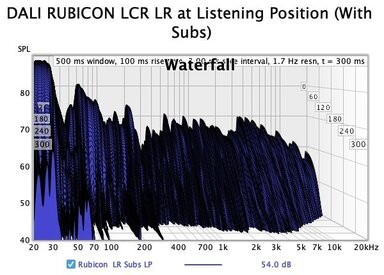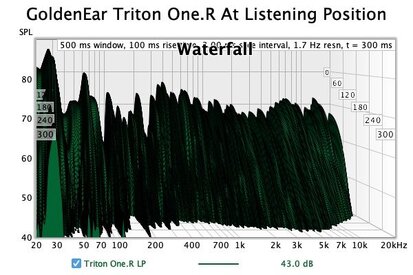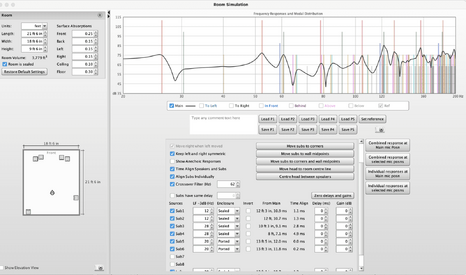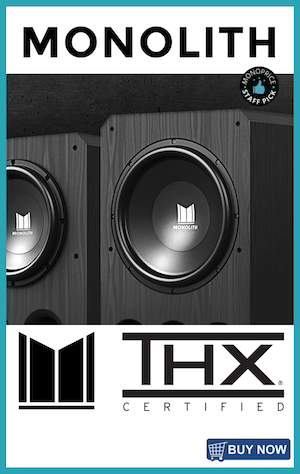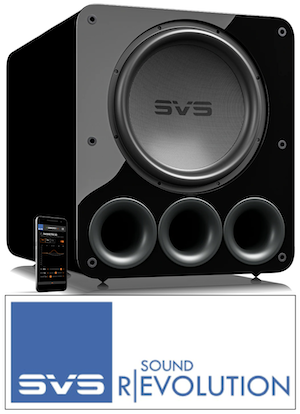- Manufacturer & Model
- DALI RUBICON LCR Speaker
- MSRP
- $1599 Each – Selected dealers worldwide
- Highlights
- A high-quality speaker system optimized for on-wall mounting
Woofer and the closed-back Hybrid Tweeter assembly are effectively isolated cabinet chambers
Ported cabinet for high-performance bass in a small enclosure
The Hybrid Tweeter Assembly can be removed and rotated 90˚, allowing it to be positioned horizontally for center channel use
2 ½ way Crossover design
Available in four finishes
- Summary
- A beautifully constructed speaker system, it is available in four finishes. A unique Hybrid Tweeter Assembly using a combination of a soft dome tweeter and a planar ribbon tweeter provides a smooth extended high-end, and very wide dispersion. The main cabinet chamber is a bass-reflex design (ported), and the long excursion, 6.5" woofer pumps out convincing, solid bass into the room. Though optimized for on-wall mounting, the speaker can also be used as a bookshelf speaker.
The Review
This review was to be my first experience with Danish Audiophile Speaker Industries (DALI) products. The Danish company is a former audio retailer that turned to design and manufacturing due to customer demand. DALI, as the speaker manufacturer, has been creating and selling speakers since 1983.
Fast forward to today, and DALI's obsession with music (It's part of their logo :-) has naturally and organically branched into the home theater and multi-channel audio markets.
When given the opportunity to audition the DALI Rubicon LCR speakers for this review, I enthusiastically agreed. Happily, DALI sent five of the Rubicon LCR speakers for review as a 5.1 system.
The DALI RUBICON series of speakers sit in the second tier of the DALI hierarchy of passive speakers. The RUBICON LCR is the entry-level option to the Rubicon series. DALI offers an incredible array of speaker choices that include both passive and active/wireless solutions at every price point. A look at the DALI website is highly recommended!
I looked over the specs and the design whitepaper for this lineup of the DALI retinue, and a couple of things struck me. First, what appeared to be a strong customer-driven design-based philosophy, and second the many design innovations that DALI was touting.
I was eagerly looking forward to putting these speakers to the test with all of that in mind!
Delivery Day
The speakers arrived via FedEx in five small, printed cardboard cartons.
The exterior of the cardboard cartons appeared to be in good shape, so up all five went to my listening space.
Unpacking revealed a robust, heavy-duty cardboard box with the speakers (grilles attached) secured between formed Styrofoam end caps. In addition, each speaker was wrapped in a soft cloth/foam baggie. The only other items in the box were the instruction manual and eight tiny stick-on rubber feet.
I judged the packing to be appropriate for the size and weight of the speakers.
First Impressions
The fit and finish on the RUBICON LCR is exquisite. Turning the speaker over in my hands gave the distinct impression of a solid and well-built product. The unique Hybrid Tweeter Module appeared exactingly machined and fitted. The speaker back is a modular affair that houses the recessed speaker binding posts capped with two of the largest binding post nuts I have seen on a speaker this size. Rolling back the binding post nuts revealed a generous oval-shaped through-hole that readily accepts 10-gauge bare wire, possibly even 8-gauge wire if flattened a bit.
Construction and Design
The robustly constructed cabinet uses MDF all around. The critical front panel is 25mm (63/64"), with the sides slightly less. The back panel is CNC milled and channeled 18mm (45/64") MDF. The channels along the rear will accept a ten-gauge wire from the top, bottom, or either side. Two robust “keyhole” plates are fitted to the rear of the speaker to facilitate on-wall mounting.
The twin cabinet ports on the backside are channels covered with two securely fastened metal plates. The ports exit at the bottom of the speaker, allowing the flush mounting of the speakers directly on the wall. If using as bookshelf speakers, you are still covered mechanically, by the chamfered backplate, allowing plenty of breathing room while sitting on a flat surface.
The cabinets are available in a high-gloss white, high-gloss black, and real wood veneer in Walnut and Rosso wood finishes. My review samples were in the Walnut finish.
The cabinet is very inert and well braced, and the only thing the "Knuckle Rap Test" accomplished was to bruise my poor little knuckles without producing any hint of hollowness or ringing.
The cloth over ABS plastic grilles are held securely in place with the “pin-in-cup” arrangement.
The drivers used in the RUBICON LCR are all DALI designed and built and utilize the unique Hybrid Tweeter Module and a 6.5" woofer with a wood pulp cone.
The Hybrid tweeter features a 29mm (1 9/64") soft dome tweeter (3.1kHz and up) and a 17mm x 45mm (43/64" x 1 49/64") planar ribbon driver handling the extreme high frequencies (14kHz and up).
More from the DALI website:
"In the RUBICON LCR, DALI makes use of both the soft dome tweeter working alone, and the hybrid tweeter configuration producing an amazing rendering of the high frequencies. The voice coil used in the RUBICON LCR is designed to be very light and agile in order to achieve a broader bandwidth. This lighter voice coil is placed inside a powerful ferrite magnet that keeps tight control of its movements.
The ribbon tweeter is the master of wide dispersion, and combining it with the soft dome, the tweeter module starts working as low as 2.5 KHz. This extreme bandwidth combined with the ultra-wide dispersion is an important part of the DALI sound philosophy."
The 6.5" woofer is built using a wood fiber cone and a DALI design motor system suspended in an Aluminum basket featuring their SMC "Linear Drive System" Technology. According to DALI, the combination of these technologies makes for better response and lower distortion than many other designs.
More from the DALI website:
"The cone used in the RUBICON LCR draws upon the heritage from the EPICON technologies and has a light, rigid, and randomly uneven structure. This lowers the complexity of the central part of the motor, ensures even piston-like movements, reduces the possibility of surface resonance greatly, and creates an extremely low distortion within the RUBICON LCR.
The soft low-loss rubber surround is designed and bespoke specifically for the RUBICON LCR. All components are situated in an aluminum chassis designed for maximum airflow around the cone and magnet system.
SMC: With the introduction of the SMC-based "Linear Drive System," we've broken new ground in the loudspeaker industry. Utilizing the technologies behind the SMC in the RUBICON LCR, we aim to create an extremely low distortion and maximize the level of details, even at low volume. With the drivers manufactured in-house at our Danish factory and featuring the latest magnet motor technology, the RUBICON LCR is ready to set new standards for audio quality for Hi-Fi lovers around the world.
The RUBICON LCR draws upon the heritage from the SMC-based 'Linear Drive System, which was introduced with the EPICON series. With the use of the technology from the SMC drivers, we have taken a step closer to remove a very large part of the unwanted distortion. The bass drivers are optimized for a long excursion. The midrange driver is optimized for a wide useful frequency range, ensuring that the roll-off is handled in the crossover and not in the driver. All this ensures that the benefits derived from SMC technology can be enjoyed by even more Hi-Fi lovers around the world."
The crossover in the RUBICON LCR is described as a 2 and 1/2-way device. Initial handover to the tweeter module is at 3,100Hz to the dome tweeter and then subsequently at 14,000Hz to the planar ribbon tweeter.
A quick peek at the crossover through the opening made by removing the Hybrid Tweeter Module (to rotate the module for horizontal center channel placement) revealed a simple, straightforward, crossover design. The quality of the crossover components appears to be very good and is proportional to the cost of the speaker, which is to say top-notch. Air core inductors, precision resistors, and high-quality capacitors are soldered to metal feedthroughs on a phenolic board. The components appeared to be connected point-to-point rather than using traces on the bottom of the mounting board (I did not Remove the circuit board to confirm).
The type of crossover is not specified, but if I were to guess from the components used and the layout, I would say it is a 2nd order Linkwitz-Riley with an 18dB to 24dB per octave slope at the 3.1kHz crossover point from the woofer/mid-range to the tweeter module. The second crossover point at 14kHz appears to be a simple LC divider, probably with a soft slope of 4dB to 6dB per octave from dome tweeter to planar ribbon “super tweeter” for a wide smooth blending of the two tweeters.
Setup
While DALI markets the speakers as on-wall speakers, the accompanying user's manual indicates the speakers can also be used on flat surfaces as a bookshelf or as furniture-borne speakers. I set up the DALI RUBICON LCR's in my main listening room as bookshelf speakers.
I replaced my reference LCR front speakers and side surround speakers with the DALI Rubicon LCR speakers. For the right and left speakers, I utilized two Definitive Technology P15 subwoofers (i.e., newly commissioned Speaker Stands) and those subwoofers/speaker stands, in turn, sitting atop two stacked concrete isolation platforms. Using this "speaker stand" approach, the RUBICON tweeter modules were right at my seated ear level.
The Hybrid Tweeter Module was removed in one speaker and rotated 90˚ to make it a center channel speaker. Next, I swapped out my reference center channel speaker with the modified RUBICON LCR.
I set up the remaining two speakers to replace my regular surround side speakers. My standard LCR speaker cabling (10-gauge pair x 2 - 8-gauge equivalent) was used for the LCR speakers. I ran new runs of 14 GA generic Belden speaker cables to the side surround speakers.
The speakers were paired with my two Rythmik F18 subwoofers (18" 900w RMS). The front right and left speakers are driven by a Parasound Halo A21 (400w into 4 ohms) amplifier. My five-channel, Parasound Halo A52+ (255w into 4 ohms) amplifier powered the center and side surround channels.
The Marantz/Audyssey MuliEQ app was used to calibrate the system by performing an 8-position calibration routine. I limited the Audyssey effect to 300Hz and below, leaving the mid-range and top-end unaffected.
The system was set up and used as a 5.1 surround system throughout all testing except where expressly noted as stereo.
Measurements
Assembling my trusty MacBook Pro with the MiniDSP UMIK-1 and utilizing REW Pro for the measurements, I set out to see what I could see. Measurements would be straightforward from both my usual listening position and from 1 Meter.
DALI claims a frequency response of 59Hz – 34kHz +/- 3dB with a modest sensitivity of 89dB, 2.83V (2watts) @ 1 Meter with a nominal impedance of 4 ohms.
I started with a measurement of the center channel speaker only at the listening position. Dead center in front of the speaker, the least amount of room interference was noted. Testing the center channel gave me a measurement much closer to the claimed lower frequency extension 59Hz +/- 3dB.
My measurement at 1 meter with no subs and the right speaker only driven showed about a 10dB drop at 59hz instead of the claimed +/-3dB. I'll blame my room for that and the fact that it is not a quasi-anechoic, let alone an anechoic chamber by any stretch of the imagination. The above measurement did show a very respectable bass presence down to 40Hz.
A measurement below from the listening position appeared to be even worse with the room fully factored in.
As far as the claimed high-end extension to 34kHz, I suppose it is possible. The limits of my modest measurement gear prevent me from confirming that in any way. However, what I do see, is the high frequencies extending out, in a relatively smooth manner, to where those equipment limitations come into play. Check out the one-meter measurements and note that it is flat to 20kHz and extends to my operational limit of 24kHz with plenty of apparent energy extending onward.
What does that extension mean? Well, to me, it ensures that any frequencies that are present in that upper stratosphere, and in the audible range, will be sent into the room as presented to the speakers. Most recording engineers and most playback mediums purposely roll-off upper frequencies to get rid of the highest frequencies above 18.5kHz anyway. Even modern recording equipment is constricted by real-world hardware/software limitations preventing the realistic capture of anything much above 18kHz to 19kHz. So, while nice to claim and offer those extreme high frequencies, anything beyond 20kHz is both naturally and through the playback and recording equipment, limited anyway.
DALI claims that the wide dispersion of the RUBICON LCR is because of the unique Hybrid Tweeter Module. I wanted to test that claim as much as my equipment allowed. With the protractor in hand, I measured the on-axis and off-axis response at one meter. I first measured the on-axis response and then shifting the microphone to the 30˚ and 60˚ marks off the center axis. The results are below.
Looking at the off-axis response above indeed confirms DALI's claim of superb off-axis response! This wide dispersion was easily vetted by a simple walkabout the speaker while listening. The sound remained consistent and listenable to around 50˚ off either side of the center axis!
DALI makes a big point of the lower distortion levels of their speakers. While several factors play into this claim including, simpler mechanical motor systems with tighter tolerances, lower hysteresis losses, less competition between the magnetic EMF generated and the woofer basket materials (Aluminum), among others are emphasized by DALI. A lower level of distortion is always a good thing in most circumstances. Indeed, the DALI speakers measure well, as seen in the chart below.
I include the following harmonic distortion chart generated by REW for reference. In addition, a harmonic distortion graph for my GoldenEar Triton One.R speakers is included as a basis for comparison. Looking at both charts, you can see that the distortion levels on the DALI RUBICON LCR are excellent and compare favorably (mostly) with the more expensive Triton One.R.
Listening
DALI markets itself as a "music first" loudspeaker company. Their motto is "In Admiration of Music." With that in mind, I set about listening to a lot of music, both in stereo and multi-channel. And, since DALI supplied five speakers, I also was determined to put the speakers through their paces as a home theater system as well.
I'm not a massive believer in the necessity of break-in/run-in of components. With that said, I do believe that many speakers do benefit marginally from a break-in period. The speakers supplied to me were evaluation speakers, so mechanical break-in was not likely to be an issue.
The only form of required break-in and speakers that I fully believe in is between the ears. Before performing any critical listening, I used the speakers constantly for a solid week while listening to my standard array of sources and source material to acclimate my "gray matter" and ears.
I assembled the "usual suspects" in musical source material and started listening. I began listening with the subs off and the speakers running full range to get a feel for how the speakers stood on their own. The sound without the subwoofers was engaging but a bit thin. I determined that all subsequent listening would be with the subwoofers in the mix unless noted.
Music
I started my listening session in stereo before jumping into 5.1 multi-channel sound.
First up was a selection from the 2000 CD release by Kansas, Somewhere to Elsewhere. The first track, "Icarus II," is a standout (IMHO). The Rubicon LCR's presented the progressive rock sounds in a forward and detailed manner. The center imaging was rock solid, and the soundstage was good but limited.
I was immediately struck by the very coherent, substantial, and thoroughly enjoyable drum sound presented by the speakers. The snare had snap and weight, and the cymbals had appropriate sizzle and crispness without any hint of harshness. Vocals presented with clarity, emerging clearly from the mix as needed. The vocals had good weight without any signs of the congestion/chestiness that some speakers can impart to male vocals.
Next, I queued up a CD from Dave Grusin and Lee Ritenour, the 1985 release of Harlequin. I love the recorded sound of this CD. The soundstage can be lush, open, and airy through the right speaker.
Through the DALI RUBICON LCR speakers, that potentially lush soundscape was presented in a somewhat muted, more constricted way. That is not to say the projected aural imagery was troubled in any way. It wasn't! It was just different than what I was expecting.
As before, the percussion sounds and the vocals from Ivan Lins were very well presented. In addition, Dave Grusin's piano had a very organic and warm overall sound that was pleasing. Lee Ritenour's guitar also had a wonderfully warm and engaging sound throughout.
The 1987 CD compilation of "New Electronic Music" from Windham Hill (Various Artists), Soul of the Machine, presents that genre of music with open, airy, and lush studio sculpted soundscapes. I sampled "Rizzo" by Mitchel Forman and "Time and the River" by Fred Simon (tracks 1 and 2).
The RUBICON LCR speakers presented this music, as with the Harlequin tracks with a somewhat limited soundstage. The sound, despite the slightly constricted soundstage, was warm, inviting, and thoroughly engaging.
To get a taste of how the RUBICON LCR's performed with classical music, I dusted off my 1999 CD of the Best of Frederic Chopin as performed by the Slovak Philharmonic Orchestra, Libor Pesek Conductor. This all-digital recording presented very well on the DALI speakers with excellent representation of space and detail. Louder passages were convincing, and the piano was reproduced with appropriate weight and a very natural timbre when featured. Wood instruments were appropriately warm but detailed.
After listening to several other tracks from various artists with similar results in stereo, I turned to my small multi-channel sound collection on SACD.
I started with one of my goto SACD's, the 2004 release Brain from frenetic master keyboardist Hiromi. I sampled two tracks from this well-recorded release, including "Kung-Fu World Champion" and the title track, "Brain." Each track played through the DALI speakers well represented the range and energy of Hiromi and her superb backing players Tony Grey, bass, and Martin Valihora, drums. The piano and drums were once again exceptionally well presented. In addition, the exciting synth parts popped and were well rendered throughout by the speakers. All five of the RUBICON LCR's working with this very well-done multi-channel recording presented a wonderfully powerful and coherent soundstage.
From the frenetic Hiromi Uehara, I moved toward the more laid-back stylings of Norah Jones. Her inaugural 2002 solo release Come Away with Me has stood the test of time. Countless "audiophiles" still reference this benchmark recording. The DALI speakers presented Ms. Jones' breathy and nuanced voice on "Don't Know Why" and "Cold Cold Heart" very well indeed. The drums had the great detail I now expected, and the upright bass had a natural, rounded, and woody timbre. The 5.1 surround sound, in this case, is more limited to ambiance duties rather than SFX and the surround speakers added a very natural openness and presence throughout the recording.
Lastly, I went back to, what is probably my favorite multi-channel SACD, the 2011 remix and re-release of Pink Floyd's 1975 classic, Wish You Were Here. The side channels get a proper workout on this remix, and the RUBICON LCR speakers proved they were more than up to the task.
The speakers played the complex and punchy effects of "Welcome to the Machine" loud and with aplomb. Each "burp, burble, and slam" was delivered with clarity, power/punch, and balance. An excellent tight connection was present between bass, synth, and kick drum throughout the entire recording.
Music Summary
I enjoyed my time spent listening to music through the DALI RUBICON LCR speakers. After settling in with the DALI's, I came to appreciate their warm but transparent, mid-range, and eminently clear and smooth extended high-end. In addition, the rendition of acoustic instruments, particularly drums/percussion, and the notoriously difficult to reproduce, full-range piano sounds were exceptionally well reproduced.
Home Theater Sound
I ditched cable/satellite about two years ago and have moved to physical and streaming media to get my video/home theater fix. I ran the DALI speakers as a 5.1 system to good effect, adding back some ATMOS representation only when watching the newly released Free Guy on Apple TV/iTunes.
I watched several different movies and television shows while using the DALI Rubicon LCR speakers. Here is an abbreviated list with brief comments.
I started with Apple TV+ and watched the first two inaugural episodes of Foundation. I hugely enjoyed the Isaac Asimov series of novels Foundation, Foundation and Empire, and Second Foundation as a young lad just discovering Science Fiction in the sixties. The producers of this series have started strong, and I'm hoping that the series continues along this path.
The production values are strong with outstanding visuals and excellent sound delivered in Dolby ATMOS. While I did not utilize the ATMOS sound when watching Foundation on this initial run-through, the DALI speakers did an admirable job with the 5.1 set up I had selected. The DALI speakers tightly connected the aural cues and FX to the visuals on the screen. The dialog was near-perfect through the DALI RUBICON LCR used as the center channel speaker. The spoken word was crisp and focused. Male voices could impart power when needed but were never overblown, chesty, or congested. Female voices were very natural sounding.
Moving to Disney+, I sampled the Star Wars Saga, Rogue One. Watching the movie's first thirty minutes in 5.1 surround engendered an impression of solid, well-connected sound and effects.
Sticking with Disney+ and jumping to the Marvel Universe, I watched the Guardians of the Galaxy (Part One) in its entirety. Again, the sound cues and FX remained tightly connected to the visuals. The dialog was once again well rendered with clarity and focus.
Watching YouTube videos can sometimes be a negative experience depending on the quality, or decided lack of quality, on some channels. Through the RUBICON LCR's, YouTubers (spoken word/info stuff) sounded pretty good. Presenters, either male or female, sounded natural.
Music videos generally had a good balance and sound. However, as you would expect, the speakers did little to help with poorly recorded content. No speaker can.
Moving to Apple TV 4K/iTunes, I played my latest purchase, the Ryan Reynolds vehicle, Free Guy. This movie is presented in Dolby ATMOS. Wanting the full effect, I re-enabled my overhead ATMOS Speakers (4 x Polk PC-6 ceiling speakers) and my two rear channel speakers for a 7.2.4 system configuration. This enjoyably goofy movie has a great soundtrack full of LFE and effects moving around the speakers. The ATMOS was there as well, adding ambiance and overhead information. The RUBICON LCR speakers blended well with the added speakers, never standing out and consistently delivering the goods without protest.
UPDATE: I just watched the third installment of Foundation. I'm happy to report the series continues to impress just as much as the DALI RUBICON LCR speakers! For the third episode in the new series, I took advantage of the Dolby ATMOS soundtrack using my overheads and rear speakers for an expanded soundstage. Just as with Free Guy, the RUBICON LCR's worked perfectly with the ambiance created by the addition of the overhead and rear speakers.
Watching Summary
I was incredibly impressed with the RUBICON LCR when recreating dialog, especially the spoken word. Both male or female voices were reproduced with clarity and focus, and for the most part, lacking (quality of recording notwithstanding :-) the artificiality, or boxiness, that sometimes plagues many speakers.
The DALI speakers paired well with my Rythmik F18 subwoofers and delivered plenty of slam when required across the entire audio spectrum. At any volume, low, medium, or extreme, the speakers performed without issue, never sounding stressed or strained.
Summary and Closing Thoughts
The DALI RUBICON LCR is undoubtedly a fine speaker. Neutral and natural sounding, they were exceptionally competent at reproducing acoustic instruments. Piano and percussion were standouts with well-recorded music, and acoustic guitar was crisply rendered but presented with a warm, woody feel. I can fully understand why DALI claims their speakers are made "In Admiration of Music" or music first.
The smallish RUBICON LCR is naturally a bit shy on bass. They are as limited by cabinet size and woofer surface area as any other speaker. The DALI technology built into the drivers makes a valiant effort to overcome those limitations, but physics is still an immutable taskmaster in the end. If you are curious beyond this review, and I hope you are, DALI has an excellent Whitepaper write-up explaining their technology on their website that I highly recommend reading.
While the bass from the single, small woofer may be somewhat lacking. That issue is easily remedied with a speedy subwoofer or two (or three or four.…). Please note that the same driver does deliver an exceptionally smooth and listenable mid-range.
But something magical happens above 3.1kHz. That is, of course, the shining star of the speaker, the unique Hybrid Tweeter Module. The combination of the soft dome tweeter and the planar ribbon tweeter is genuinely inspired. Essentially combining that silky smooth dome tweeter with a planar ribbon super tweeter, crossed over softly at 14kHz, the high end of this speaker is smooth, crisp, and extended well beyond any practical hearing or recording capabilities. In addition, the very wide dispersion capabilities, and the beautiful rendering of the high-end, adds buckets of air and presence to the mix when present in the source material.
Perversely, the perceived soundstage depth and width seemed a little lacking, at least to me! Other rooms might just produce, or other ears just might hear, something different. In other words, "Your mileage may vary!"
The DALI RUBICON LCR speakers performed exceptionally well as the heart of my home theater system. I sampled several steaming video presentations from AppleTV+, YouTube, iTunes, NetFlix, and Disney+, and the speakers never came up short. Effects tracked well and remained tied firmly to the action on the screen. The admittedly potential overkill of my Rythmik F18 subwoofers was never an issue. When used with my other speakers, the Rubicon LCR's blended well, never overtly standing out or interfering with the aural imaging.
The DALI speakers played plenty loud enough without any hint of stress, strain, or compression artifacts, for any sensible person… Even me!
As you might be able to tell, I liked a great deal about my time with the DALI RUBICON LCR speakers. The small speaker flexed well into the roles I placed it in. It handled multiple genres of music and home theater with equal aplomb. And, it looks beautiful!
How would the larger DALI speakers perform, I wonder? If performance scales up with price and size, I think very well indeed when based upon the strengths of this smaller speaker.
Highly Recommended!
Specifications: DALI RUBICON LCR Speaker
Frequency Response: 59Hz to 34,000Hz
Sensitivity: 89dB 2.83V (2 watts)/1 Meter
Nominal Impedance: 4 ohms
Maximum SPL: 109dB
Crossover Principle: 2 and ½ way
Crossover Frequencies: 3.1kHz/14kHz
Hybrid Tweeter Module - Super Tweeter: .669" x 1.77" (17mm x 45mm)
Super Tweeter Type: Planar Ribbon
Hybrid Tweeter Module – Tweeter: 1.14" (29mm)
Tweeter Type: Soft Textile Dome Tweeter
Woofer/Mid-Range: 1 x 6.5”
Cone Material: Wood Fiber
Enclosure Type: Bass Reflex
Bass Port Tuning: 49Hz
Connection Type: 5-Way Binding Post
Magnetic Shielding: No
Recommended Placement: On-Wall or Free Standing
Dimensions: 18.31” x 10.95” x 5.59” (465mm x 278mm x 142mm)
Accessories Included: Manual, Micro Fiber Cloth, Rubber Bumpers (Feet)
Weight: 17.64 Pounds (8kg)
Last edited by a moderator:







